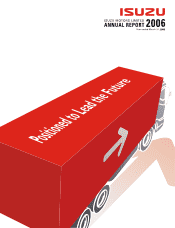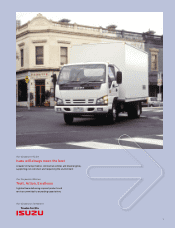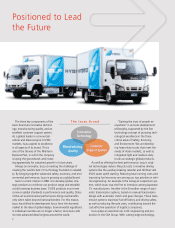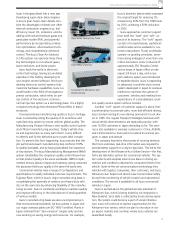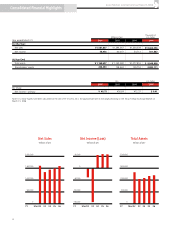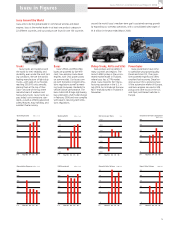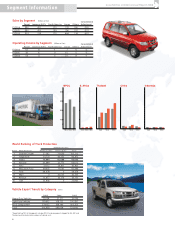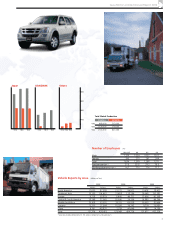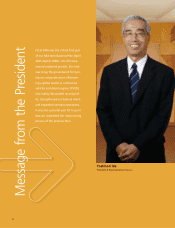Isuzu 2006 Annual Report Download - page 11
Download and view the complete annual report
Please find page 11 of the 2006 Isuzu annual report below. You can navigate through the pages in the report by either clicking on the pages listed below, or by using the keyword search tool below to find specific information within the annual report.
9
Amid an increasingly unforgiving operating environment, in-
cluding a steep rise in crude oil prices that had a severe impact on
the logistics industry—our main customers—domestic demand
did not increase as much as expected despite the new emissions
regulations. The rising price of steel and other raw materials also
put pressure on earnings. Nonetheless we posted sales and profit
growth for the third consecutive term, posting record profit again
in fiscal 2006 (ended March 31, 2006). Consolidated-basis sales
grew 5.9% to ¥1,581,857 million, operating profit was up 4.0% to
¥90,661 million, working profit rose 2.5% to ¥93,843 million, but
net income fell 1.8% to ¥58,956 million due to completion of re-
structuring. We made steady progress with balance sheet improve-
ment, with the debt-equity ratio moving closer to our target of 1.0
at 1.4 at the end of fiscal 2006 compared with 2.5 a year earlier.
Looking ahead to fiscal 2007, business conditions remain chal-
lenging with no sign of weakness in raw materials and crude oil
prices. We therefore cannot expect demand to increase in Japan
and other established markets, but we forecast a similar level of
sales as in fiscal 2006 as a result of pioneering new overseas mar-
kets, aiming for a fourth consecutive year of record sales, operat-
ing profit, and working profit.
Fiscal 2006 proved to be a milestone year in more ways than
one. Notably we finally managed to clear our “negative legacy” of
extraordinary losses associated with restructuring in the fiscal year
ended March 2006, marking the completion of the corporate re-
structuring process. With a healthy management structure, we are
now poised to begin expanding our business in earnest. Another
achievement was that our operations in all markets went into the
black—the result of price reviews that reflect product value as
well as cost reduction efforts. We intend to maintain our “price
for value” concept as we pioneer new markets going forward. At
the same time we are not neglecting the domestic market. We are
striving to increase market share while making a fair profit, and
exploring a more comprehensive business model, offering our cus-
tomers a broad range of products and services.
The future vision outlined in the Isuzu Mid-term Business Plan
is to become a global leader in the commercial vehicle and diesel
engine (CV/DE) markets. This is not a hazy dream, but a goal that
we are committed to achieving in the not-too-distant future. What
do I mean by a global leader? My definition consists of three basic,
minimum components—world-class people, products, and quality.
People make or break a project. We are looking to our develop-
ment division to carry Isuzu’s critical undertaking—developing a
standard strategic global product range of light-duty and medium-
duty trucks developed to overseas standard specifications. These
strategic products designed for the world market will play a key
role in our efforts to expand our overseas CV market share and in-
crease overseas CV sales to 300,000 units. Since fiscal 2006, we
have been building the foundations for growing our overseas busi-
ness, such as establishing a sales company in Mexico, making our
Australian sales company a wholly owned subsidiary, and expand-
ing operations in the Ukraine.
The integrated light and medium-duty trucks that we are in-
troducing in stages from fiscal 2007 are strategic, standardized
vehicles for the global market. These are totally new trucks devel-
oped to global standard specifications. Customers expect the same
superior performance and durability of Isuzu vehicles regardless of
the country or region. Our new range of world-class trucks maxi-
mizes our competitive advantage, incorporates the SEE technology
in development, and can match and surpass the best that our com-
petitors have to offer.
Quality is an eternal theme for manufacturers. Quality defects
that emerged in fiscal 2006 represented a serious setback for
Isuzu. We are making renewed efforts to prevent quality problems
by rigorous change management, and resolving any issues that
occur at the earliest possible stage.
Attaining the targets of our current Mid-term Business Plan en-
tails five major undertakings. First, we must ensure that we never
overlook information about a possible defect, and willingly share
it with all concerned. We need to become more sensitive to infor-
mation about defects that customers and sales companies provide,
ensure that it is passed on to others in the company, and resolve
problems as quickly as possible. Second, we must implement rig-
orous change point management practices. This will prevent most
defects, which are caused by a lack of attention to detail in change
point management. Third, we need to maintain and maximize our
strengths as the “real truck professionals.” Customers come to
Isuzu to buy professionally built trucks. At the same time we must
study their requirements so that we can give them what they are
looking for. Fourth, managers should spare no effort in putting
themselves in the position of their front-line workers, keeping track
of day-to-day developments and taking personal responsibility for
completing tasks. Hands-on involvement helps managers keep
their fingers on the pulse of business activity and identify prob-
lems at an early stage. Fifth, each and every employee must have a
thorough and accurate understanding of compliance and business
ethics. The behavior of Isuzu management and employees must be
beyond reproach.
In the longer term, we are focusing on building a solid business
structure consisting of four core businesses—the CV business in
Japan and overseas, and the light commercial vehicle (LCV) and DE
businesses—and ensuring sustainable growth. This requires finding
and maintaining the right balance of management resources. We
are looking ahead at meeting the Post New Long-Term Emissions
Regulations that take effect in 2009, and strengthening collabora-
tion with General Motors as we move into a new phase of our re-
lationship with the company following the dissolution of the equity
partnership. In addition to the numerous successful collaborations
in development, manufacturing, and distribution of vehicles and
engines worldwide, we will be taking advantage of GM’s exten-
sive sales network in emerging markets in the Middle East, South
Africa, and Latin America.
With two years left to run of our Mid-term Business Plan, we
look forward to your continued support as we forge ahead with
our mission to become a global leader in the commercial vehicle
business.
June 2006
Yoshinori Ida
President & Representative Director
Isuzu Motors Limited Annual Report 2006

